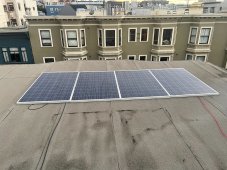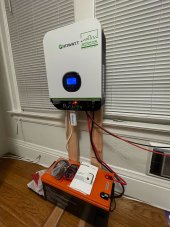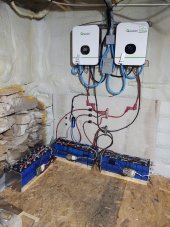audia4_20t
New Member
- Joined
- Nov 7, 2022
- Messages
- 12
I wanted to post my setup after running it for a few months, with some questions around breakers, fuses, and settings since that is the last piece of the system.
Initial Problem: my electricity bill in California was very high, and I rent my apartment so anything grid-tied or permanent was out of the question. However, I am on the top floor of an old house with roof access. Thanks to Will Prowse for making all the videos helping me understand how it all works!
Solution:
Initial Problem: my electricity bill in California was very high, and I rent my apartment so anything grid-tied or permanent was out of the question. However, I am on the top floor of an old house with roof access. Thanks to Will Prowse for making all the videos helping me understand how it all works!
Solution:
- Growatt 3000TL 24v Inverter
- Chins 24v 100ah Battery
- (8) used 250w Canadian Solar Panels. Set up in two series strings of 4.
- Since my goal was not to be fully off grid and I didn’t get a big battery, I have the system using solar, then batteries, then grid bypass only if the battery goes too low.
- This setup has been doing about 3-4kwh per day after adding the second string in the winter. I imagine in the summer it will do 6-7kwh
- Max production I’ve seen is around 1400w. The panels are laying flat so I don’t need to permanently attach them so I’m happy with that.
- I’ve had enough juice to run a little space heater in the morning for awhile and an AC unit for a couple hours in the summer.
- I power my home office all day and a fan/phone chargers at night.
- Overall I’m really happy with how conceptually simple this was, but users *REALLY* need to be tech and electrically savvy to understand what they’re doing.
- Inverter Settings (see chart from Chins sent below)
- Setting 2: 50A max charging current
- Setting 11: 20A maximum utility charging current – should I set this higher? I guess I could set it at 50A for when the battery is too low. The battery can take 100A of charging.
- Setting 12: 23.3v – does this look right based on the CHINS settings?
- Setting 13: 24.8v – does this look right based on the CHINS settings?
- Setting 19: 28.4v – does this look right based on the CHINS settings?
- Setting 20: 28.4v – I’m really confused about this. Nomatter which one between 19 and 20 I set, it changes both of them. I originally had them both at 27.6v but it seems awfully low compared to what the battery can handle
- Setting 21: 23.2v - does this look right based on the CHINS settings?
- Current Protection
- I set my max total battery charging amps to 50 because the solar doesn’t ever seem to get much over ~35 and I don’t use the grid to charge the batteries unless the solar isn’t enough. I got a 60A breaker here https://www.amazon.com/dp/B004XXOW0E?psc=1&ref=ppx_yo2ov_dt_b_product_details. Is that good for the positive lead on the DC battery side?
- I have (2) 15A MC4 fuses on each string. Does that seem right?
- I also got a 20A breaker for the power output here: https://www.amazon.com/dp/B07MZPWN27?psc=1&ref=ppx_yo2ov_dt_b_product_details. Is this all I need for an AC breaker? It says there’s a breaker on the inverter but I don’t know if that’s for the input or output.
- Should I get an AC breaker for the power input from the grid?
- Are there any other safety items I should be getting? This is my first setup.







